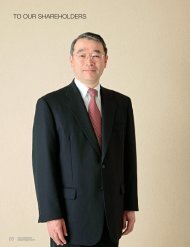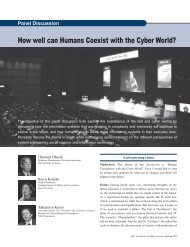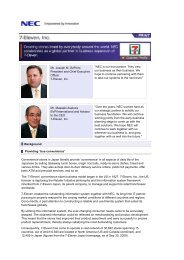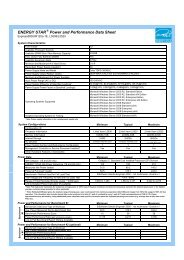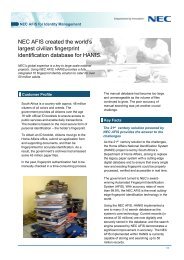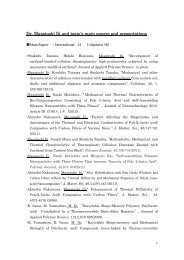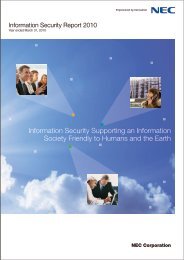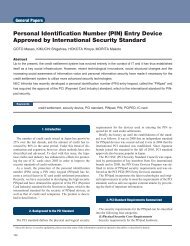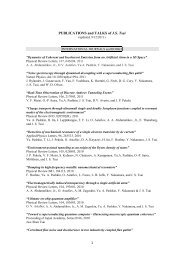Technologies Behind NEC's High Temperature Ambient Server
Technologies Behind NEC's High Temperature Ambient Server
Technologies Behind NEC's High Temperature Ambient Server
You also want an ePaper? Increase the reach of your titles
YUMPU automatically turns print PDFs into web optimized ePapers that Google loves.
White Paper<br />
<strong>Technologies</strong> <strong>Behind</strong><br />
NEC’s <strong>High</strong> <strong>Temperature</strong> <strong>Ambient</strong> <strong>Server</strong><br />
Boosting the power efficiency<br />
of data centers<br />
http://www.nec.com/
<strong>Technologies</strong> <strong>Behind</strong> NEC’s <strong>High</strong> <strong>Temperature</strong> <strong>Ambient</strong> <strong>Server</strong><br />
1. What Are <strong>High</strong> <strong>Temperature</strong> <strong>Ambient</strong> (HTA)<br />
<strong>Server</strong>s and Storage Devices?<br />
1.1 Introduction<br />
Cloud computing and other advanced information & communications technologies (ICT)<br />
are changing business and society. But as cloud services expand, so do the data centers<br />
housing the increasingly large numbers of servers and storages devices required to<br />
deliver these services, leading to increased power consumption. Corporations looking to<br />
make their data centers more power efficient and reduce their operating overhead are<br />
therefore searching for new and effective power saving measures.<br />
To address these issues, NEC is providing HTA servers and storage devices as well<br />
as solutions to help improve the power efficiency of the cooling systems and facility<br />
equipment used in data centers. This paper describes NEC’s technologies for<br />
realizing HTA servers and storage devices, including the verification tests<br />
performed on the HTA servers and storage devices.<br />
1.2 Steps taken by NEC to realize power<br />
saving servers and storage devices<br />
Looking at a data center’s power consumption figures classified by usage, ICT<br />
equipment such as servers and storage devices accounts for 53% of consumed<br />
power, whereas the cooling systems, power distribution, lighting equipment, and<br />
other facilities account for the rest (47%). (These are actual values measured in an<br />
NEC data center.) In fact, the cooling systems accounts for as much as 31% of data<br />
center power consumption. It is therefore important to reduce the power consumed<br />
by the cooling system as well as by ICT equipment in order to achieve power savings<br />
in data centers.<br />
Power Consumption in Data Center Classified by Usage<br />
Lighting and<br />
other equipment<br />
Power supply<br />
equipment<br />
7<br />
9<br />
1.3 NEC’s HTA servers and storage devices<br />
To achieve further power reduction, NEC has released a platform that operates in<br />
HTA servers and storage devices that operate up to 40 degrees Celsius (104<br />
degrees Fahrenheit).<br />
The maximum ambient operating temperature for conventional servers and<br />
storage devices is generally 35°C. NEC has successfully increased this limit by<br />
5°C to 40°C by selecting components that enable optimization of cooling design<br />
and airflow. This makes it possible to set the cooling system in the data center to a<br />
higher temperature, reducing the power consumption.<br />
The figure below shows an example of a customer that is using ICT equipment<br />
installed in 2007. If this customer replaces their existing devices with NEC’s HTA<br />
power saving servers and storage devices, the ICT equipment will consume less<br />
power and therefore generate less heat. This means that the cooling system will<br />
need less power to cool the data center. Power consumption can also be reduced<br />
by elevating the cooling system temperature setting by 5°C. These measures add<br />
up to a reduction in cooling system power consumption of approximately 40% and<br />
a decrease in data center power consumption of 34% (as estimated by NEC).<br />
Breakdown of current power<br />
consumption in data center* 1<br />
Other facilities: 16%<br />
Cooling: 31%<br />
Networks: 11%<br />
Storage devices: 9%<br />
<strong>Server</strong>s: 33%<br />
Before<br />
Reduced by<br />
40%<br />
Reduced by<br />
50%<br />
Reduced by<br />
53%<br />
*1 Actual values measured in an NEC data center<br />
Power consumption<br />
reduced by<br />
34%<br />
After<br />
Cooling system<br />
31<br />
ICT<br />
equipment<br />
53<br />
2. NEC’s <strong>Technologies</strong> for<br />
Realizing HTA Products<br />
Power saving measures for cooling systems are as important<br />
as improving the power efficiency of ICT equipment.<br />
NEC has been addressing power saving for IT platforms since 2007. We have achieved<br />
significant power savings in server and storage devices by implementing the internal<br />
airflow designs and cooling technologies proven by us in supercomputer and<br />
mainframe development.<br />
With the rapid shift to cloud computing, ICT systems are being consolidated in data<br />
centers, making it important to implement power saving measures for the whole data<br />
center, including the cooling system, power supply equipment, and lighting equipment.<br />
Determined to take a proactive approach to an issue that all corporations will have to<br />
address, NEC launched a project in 2010 to save power in data centers as a whole.<br />
NEC provides HTA servers in its Express5800 series x86 server lineup. The Express5800<br />
series incorporates the Intel® Xeon® processor with excellent power efficiency. Power<br />
consumption by these servers is also reduced by adopting the<br />
80 PLUS® PL ATINUM power supply with high conversion<br />
efficiency along with other power saving components.<br />
In addition, the Express5800 series lets you set a power cap<br />
value to control power by using the bundled ESMPRO server management software.<br />
In addition to the power saving features in the server itself, NEC has also thoroughly<br />
reviewed the airflow design and cooling components in the housing to enable high<br />
temperatures. The following sections describe NEC’s original designs for realizing power<br />
saving.<br />
© 2012 NEC Corporation The NEC logo is a registered trademark or a trademark of NEC Corporation in Japan and other countries.<br />
2
2.1 <strong>Server</strong> cooling technologies<br />
System design technology for optimizing the airflow<br />
NEC has applied to the Express5800 series the advanced cooling technologies<br />
acquired when developing mainframes, which require stability and robustness,<br />
and fast and highly efficient supercomputers. Stable operation at 40°C has been<br />
realized by thoroughly redesigning the airflow and cooling components in the<br />
server.<br />
One of these cooling technologies used for improving the cooling efficiency is<br />
an airflow guide. The challenge of server cooling is how efficiently cool air taken<br />
in from the front air inlet is transferred to the outlet on the rear. The<br />
Express5800 series servers incorporate an airflow guide to adjust the airflow.<br />
The shape and angle of the airflow guide is designed to generate the optimal<br />
airflow so that the required amount of cool air is delivered to each component<br />
without being heated.<br />
As a result of this design, 2U rack mount servers can now incorporate hard disk<br />
drives not only in the front of the main unit but also in the rear.<br />
Express5800/R120d-2E can incorporate a total of twenty-six 2.5-inch hard disk<br />
drives: 24 drives in the front and 2 drives in the rear. (Twelve 3.5-inch hard disk<br />
drives can be incorporated in the front.) Increasing the number of hard disk<br />
drives that can be incorporated eliminates the need to add servers to secure<br />
hard disk capacity, resulting in an efficient use of rack space. A large hard disk<br />
drive capacity is also beneficial for meeting big data needs.<br />
Front HDD cage<br />
Front<br />
GT110d<br />
Parts are placed parallel to<br />
the airflow direction<br />
Airflow<br />
Power<br />
supply fan<br />
Heat sink<br />
Heat<br />
exhaust fan<br />
GT110d-S<br />
Cool down<br />
CPU<br />
Cool down PCI.<br />
Offset fan placement<br />
Fan for cooling down<br />
2.5-inch SAS HDD<br />
Airflow<br />
Offset placement of fan for effective cooling<br />
— Optimal placement of power supply unit in 2-way rack server —<br />
NEC has enabled a maximum ambient operating temperature of 40°C in 2-way<br />
rack servers which incorporate two CPUs in a single server chassis, by<br />
conducting complex cooling simulations and operation tests.<br />
The layout of the power supply unit leverages NEC’s expertise to improve the<br />
cooling performance in 2-way rack servers. These servers require a high<br />
cooling efficiency because parts that generate heat, such as the 24 DIMMs and<br />
CPUs with a thermal design power of 135 W, are placed at a high density. By<br />
placing the power supply units and CPUs as shown in the figure below, cool air<br />
can be supplied to both the power supply unit and CPUs in such a way that air<br />
heated by the CPUs does not flow into the power supply unit again. The cooling<br />
performance of the two power supply units has also been improved by<br />
separating them, and the airflow efficiency has been raised by laying out the<br />
power supply units and CPUs symmetrically.<br />
2.5-inch drives (24 units)<br />
3.5-inch drives (12 units)<br />
Rear<br />
Rear HDD cage<br />
Airflow<br />
R120d-1M<br />
Rear<br />
2.5-inch drives (2 units)<br />
Guide cool air to the HDDs in the rear<br />
by fine-tuning the airflow<br />
Front<br />
Placing supply units away from<br />
the hot air flowing from the CPUs<br />
Layout technology to optimize airflow<br />
NEC has devised a layout to optimize airflow by leveraging the strength of its<br />
in-house design and development of motherboards. Cool air is designed to flow<br />
in a straight line from the front intake to the rear of the housing in this design. In<br />
tower-type servers, memory slots are placed horizontally so that the airflows in<br />
a straight line, whereas these slots are generally placed vertically.<br />
In addition, a larger heat sink and duct are employed to efficiently cool down<br />
the CPUs which generate a large amount of heat. Offset placement, in which<br />
the position of blower fan is intentionally shifted, is used to generate airflow that<br />
allows a single fan to cool down both the CPUs and the PCI slots. On top of<br />
that, this product is designed to allow airflow in a straight line from heat<br />
sources by inclining the heat exhaust fan to directly and efficiently cool down<br />
the PCI slot, which generates heat.<br />
Operation guaranteed at an ambient temperature of 40°C<br />
to help reduce the power consumption of cooling units<br />
A cooling design that enables operation at an ambient temperature of 40°C was<br />
realized in an innovative 2-way rack server by conducting complex cooling simulations<br />
and operation tests. (The guaranteed ambient operating temperature is generally 35°C.)<br />
Power<br />
supply unit<br />
Express5800/<br />
R120d-1M<br />
Airflow<br />
The cooling performance of the<br />
power supply unit was improved by<br />
placing the power supply units at<br />
positions so that the airflow heated<br />
by the CPUs could not reach them<br />
and also separating them (i.e., they<br />
could be supplied with fresh air).<br />
An efficient airflow was realized<br />
by a symmetric layout.<br />
<br />
Large CPU heat sink<br />
(supporting 135W CPU)<br />
Power<br />
supply unit<br />
Airflow<br />
Express5800/<br />
R120d-2M<br />
© 2012 NEC Corporation The NEC logo is a registered trademark or a trademark of NEC Corporation in Japan and other countries.<br />
3
<strong>Technologies</strong> <strong>Behind</strong> NEC’s <strong>High</strong> <strong>Temperature</strong> <strong>Ambient</strong> <strong>Server</strong><br />
2.2Storage device cooling technologies<br />
NEC provides the NEC Storage M series SAN disk array as an HTA storage<br />
device. NEC Storage M series is a storage device that saves power by<br />
approximately 50% compared with the conventional model with the same<br />
capacity by adopting the common architecture of the Express5800 server<br />
series. The MAID (Massive Array of Inactive Disks) automatically switches less<br />
frequently accessed volumes to power saving mode to reduce power<br />
consumption.<br />
2.3 Cooling assessments<br />
The server mother boards have been designed with an optimal component<br />
layout through measurements and simulative analysis of temperature and its<br />
distribution. For measurement, temperature sensors were placed in more than<br />
100 positions, NEC also verified the cabling at the design and development<br />
phase so as to not affect maintenance work after installation. NEC’s HTA<br />
servers and storage devices have all passed these strict cooling assessments.<br />
System design technology for optimizing the airflow<br />
The adopted airflow design allows cool air to flow in a straight line from the<br />
front to the rear of the unit to improve the cooling efficiency. The structure of<br />
unit is designed considering the airflow going from the hard disks to the air<br />
holes to the control board and out through the fan.<br />
There are also air holes on the back plane to optimize airflow in order to<br />
increase the cooling efficiency between HDDs.<br />
HDD<br />
Back-Plane<br />
Power<br />
supply<br />
Blower fan<br />
3. Verification Tests<br />
Front side<br />
Rear side<br />
Control board<br />
Layout technology to optimize airflow<br />
The cooling efficiency has been improved by adopting Intel low-power<br />
processors as the CPUs and also by using a large heat sink. In addition, the<br />
airflow and component placement have been optimized to allow for the worst<br />
case scenario of fan failure.<br />
To facilitate understanding of the cooling effects of the Express5800 series and<br />
NEC Storage series, this section describes two verification tests – a fresh air<br />
cooling verification test in which the device was operated in an environment in<br />
which only the direct free air cooling method was used, and a long duration<br />
verification test.<br />
In addition to these verification tests, NEC also supplied HTA servers to Intel for<br />
assessment and verification of heat and power consumption reduction mainly<br />
from the viewpoint of the CPU.<br />
Optimal placement of power supply unit in NEC Storage M series <br />
Winner at Green IT Awards 2011<br />
The use of power supply unit with high conversion efficiency improves the<br />
cooling efficiency of the power supply unit and thus allows more cool air to flow<br />
to the control board.<br />
Optimized amount of airflow<br />
for power supply and control<br />
board<br />
Optimization of HDD airflow<br />
(Back plane air holes)<br />
Layout design<br />
considering airflow<br />
Low-power CPUs<br />
Large heat sink<br />
The Express5800 series and NEC Storage M series, which can operate at a maximum<br />
ambient temperature of 40°C, received the Green IT Promotion Council Chairman’s<br />
Award* 2 in the energy saving of IT equipment (“of IT”) category at the Green IT Awards<br />
2011. The award was received in recognition of the power saving performance of these<br />
products and the originality and innovation required to increase the ambient operating<br />
temperature to 40°C. The award in this category is given to IT devices, services, systems,<br />
and other products that deliver an excellent power saving performance.<br />
Product name/model number<br />
1-way tower: Express5800/GT110d<br />
1-way slim: Express5800/GT110d-S<br />
1-way water-cooled slim: Express5800/GT110d-S (water-cooled)<br />
1-way rack: Express5800/R110d-1E and Express5800/E110d-1<br />
SAN storage: NEC Storage M10e and NEC Storage M100<br />
*2 The Green IT Promotion Council is a Japanese industry-academic-government organization<br />
found in 2008 to address the global warming issue. The council promotes power saving through IT.<br />
© 2012 NEC Corporation The NEC logo is a registered trademark or a trademark of NEC Corporation in Japan and other countries.<br />
4
3.1 Direct free air cooling verification<br />
test in data center<br />
3.1.1 Outline of verification test<br />
Purpose<br />
• To verify the operating status of servers and storage devices throughout the<br />
year in an outdoor air intake environment.<br />
Verification environment<br />
• Data center in Tokyo with no cooling system used<br />
Equipment used for verification<br />
<strong>Server</strong> : Express5800 series<br />
Storage : NEC Storage series<br />
3.1.2 Details and results of assessment<br />
Details of assessment<br />
• The server CPU and storage IO were operated constantly in a high load<br />
state (almost 100%).<br />
• The intake air temperature, internal temperature, and power consumption<br />
were measured.<br />
Assessment period<br />
Verification has been ongoing from December 2010 until now (Septmber 2012).<br />
Assessment results<br />
Although the intake temperature of the server exceeded 35°C in summer when<br />
the outdoor air temperature exceeded 35°C, the server, whose maximum<br />
ambient operating temperature is 40°C, operated stably.<br />
Even when the external humidity suddenly increased due to evening showers or<br />
other weather conditions, the proper humidity was maintained at an optimum<br />
level inside the ICT equipment by keeping the temperature of the intake air<br />
several degrees higher than the outdoor air, using exhaust air from the server.<br />
3.2 Long duration verification test<br />
3.2.1 Outline of verification test<br />
Purpose<br />
• To confirm long-term stable operation in a high temperature environment of<br />
40°C or higher<br />
Verification environment<br />
• The server was installed in a constant temperature chamber (constant<br />
temperature oven) and exhaust air from the server was circulated, with the<br />
temperature maintained at 40°C or higher.<br />
Equipment used for verification<br />
<strong>Server</strong> : Express5800 series<br />
Storage : NEC Storage series<br />
3.2.2 Details and results of assessment<br />
Details of assessment<br />
• The server CPU was operated constantly at a high load state (almost 100%).<br />
• The server was operated in a constant temperature chamber with the<br />
temperature on the front panel of server maintained between 40°C and 42°C,<br />
with the error status of the server being checked.<br />
• The intake temperature, internal temperature, and power consumption were<br />
measured.<br />
Assessment period<br />
Verification has been ongoing from April 2011 until now (July 2012).<br />
Assessment results<br />
The server has continued to operate stably even in a high load state without<br />
generating errors for over one year. This verification test is ongoing.<br />
Constant temperature chamber <strong>Temperature</strong> of the front panel of server: 41.7°C<br />
41<br />
<strong>High</strong>est outdoor air temperature and highest server<br />
intake temperature in August in Tokyo<br />
<br />
40<br />
35<br />
<br />
100<br />
90<br />
80<br />
<strong>High</strong>est and lowest outdoor humidity in August<br />
70<br />
30<br />
60<br />
<strong>High</strong>est outdoor air temperature<br />
25<br />
<strong>High</strong>est intake temperature<br />
20<br />
Aug.1 Aug.15 Aug.31<br />
50<br />
40<br />
<strong>High</strong>est outdoor humidity<br />
Lowest outdoor humidity<br />
30<br />
Aug.1 Aug.15 Aug.31<br />
Exhaust air from the server is circulated and partly emitted<br />
to maintain a front panel temperature of 40°C.<br />
(The server is being operated at between 40°C and 42°C).<br />
The door on the right is opened briefly to measure the temperature<br />
with a thermo camera.<br />
27<br />
Advantages of HTA servers and storage devices<br />
in terms of relative humidity<br />
A humidity of 80% or less is recommended for IT devices to prevent dew condensation.<br />
With an outdoor cooling method, if the humidity of the outside air is as high as 100%, the<br />
temperature inside the data center must be kept higher than the outdoor air in order to<br />
maintain a lower humidity. In general, the relative humidity drops to approximately 80% if<br />
the air temperature when the humidity is Humidity <br />
100% rises by several degrees.<br />
100<br />
80<br />
HTA servers and storage devices are very<br />
effective in environments in which the<br />
temperature must be kept higher than the<br />
0<br />
outside air.<br />
35 39 <br />
<strong>Temperature</strong><br />
4. Applications of HTA <strong>Server</strong>s and<br />
Storage Devices<br />
4.1 <strong>High</strong>er temperature setting of cooling system<br />
The temperature of the cooling system can be set higher by implementing HTA<br />
servers and storage devices. This will reduce the power consumption of the<br />
cooling system. This section introduces an example of reducing cooling system<br />
power consumption by 37% at an NEC testing center.<br />
© 2012 NEC Corporation The NEC logo is a registered trademark or a trademark of NEC Corporation in Japan and other countries.<br />
5
<strong>Technologies</strong> <strong>Behind</strong> NEC’s <strong>High</strong> <strong>Temperature</strong> <strong>Ambient</strong> <strong>Server</strong><br />
Environment<br />
• NEC IT platform Testing Center with 200 to 300 servers, storage devices, and<br />
network devices installed.<br />
• Eight air conditioners under operation<br />
• Total power of approximately 150 kW<br />
Issues<br />
• It is difficult to separate cool and warm air because there is no underfloor<br />
cooling system.<br />
The environment used for verification is a space designed to assess ICT<br />
equipment before shipment and therefore does not have any underfloor cooling<br />
system. It was therefore difficult to control the cool and warm air.<br />
• Frequent unit displacement and fluctuation of operating rate<br />
Multiple ICT devices are tested at the same time in the testing center and the<br />
device configuration is frequently changed according to the type of test. It is<br />
therefore difficult to keep the temperature constant, leaving no choice but to set<br />
the cooling system to a low temperature to avoid the generation of hot spots.<br />
Investigation<br />
After performing measurement across the whole floor, it was found that there were<br />
many low temperature areas where the indoor temperature was 23°C or less.<br />
Analysis<br />
As a result of performing heat analysis using an analysis tool, it was determined that<br />
five air conditioners could cover the current amount of heat generation. Three of the<br />
eight operating air conditioners were therefore stopped and the optimal temperature<br />
(25°C to 30°C) was successfully achieved at the air inlets of the ICT equipment.* 3<br />
Measures<br />
We determined the positions of the three operating air conditioners that had to be<br />
stopped by using heat analysis.<br />
We also implemented measures to optimize the airflow of exhaust heat by using a<br />
capping method and adjusted the airflow direction of the cooling system for some<br />
racks to realize airflow control in which hot spots would not be generated even if<br />
those three air conditioners were stopped.<br />
Results<br />
We succeeded in reducing the cooling system power consumption from the<br />
current 24 kW to 15 kW (a reduction of 37%) without generating hot spots. This<br />
will lead to savings of approximately 1.1 million yen in annual power charges* 4 .<br />
As described above, it was demonstrated that the power consumption can be<br />
significantly reduced by raising the cooling system temperature. It is<br />
particularly difficult to maintain the supply of power to the cooling system when<br />
Development of NEC proprietary cooling technology using thermosiphon cooling<br />
Reduction in the amount of airflow required to cool down ICT equipment<br />
Because the layout of the ICT equipment in a data center is often very complicated, it is<br />
difficult to evenly feed in cool air. In general, this problem has been solved by installing fans<br />
in the ICT equipment itself to cool it directly by generating a large amount of airflow. If the<br />
CPUs and other components of the ICT equipment are more efficiently cooled down, it will<br />
require less fan airflow, and thus result in less power consumption.<br />
Based on this concept, NEC has developed a technology to cool down ICT equipment using a<br />
“thermosiphon cooling” method. With thermosiphon cooling, the heat is absorbed when the<br />
refrigerant changes from a liquid to a gas (evaporates). Applying this thermosiphon cooling<br />
technology to cool down the server reduces the fan airflow in the ICT equipment, cutting<br />
power consumption by 60% or more. This is estimated to result in a reduction in total cooling<br />
power, including that of the cooling system, of 20% or more.<br />
The amount of airflow from the cooling system<br />
can be reduced by cooling down<br />
the ICT equipment with a small amount of airflow.<br />
Amount of airflow in<br />
the ICT equipment100<br />
Elimination of hot spots Measures to reduce<br />
the amount of airflow<br />
Amount of airflow in<br />
the ICT equipment70<br />
Reducing the large amount of<br />
airflow for this rack eliminates<br />
hot spots. (It is not necessary to<br />
reduce the amount of airflow for<br />
all the racks.)<br />
It was verified that the power for the fan for a 1U server was<br />
reduced by 60% or more by adopting the thermosiphon cooling<br />
Thermosiphon<br />
cooling<br />
Features of thermosiphon cooling technology<br />
In the thermosiphon cooling method, refrigerant liquid is heated by the CPU or other heat<br />
generator and evaporates, generating a gas-liquid two-phase flow, which consists of liquid<br />
and gas. When vapor is generated in the heat receiving section, the liquid level drops in the<br />
heat receiving section, generating a level difference from the liquid in the heat emitting<br />
section. The gas-liquid two-phase flow, consisting of liquid and gas, is efficiently transferred<br />
to the heat emitting section due to gas-liquid equilibrium. Gas-liquid equilibrium is a<br />
characteristic in which the vaporization speed becomes equal to the devolatilization speed.<br />
This method is applicable even to 1U servers with a design optimized for the best airflow<br />
because a pump or other external driving force is not required to circulate the refrigerant.<br />
As the thermosiphon cooling method transfers heat using latent heat* 5 , there is almost no<br />
difference in temperature between the liquid and the gas. The gas-liquid two-phase flow<br />
<br />
<br />
<br />
<br />
<br />
<br />
technology. T he total power<br />
required for cooling, including<br />
that of the cooling system, could<br />
be reduced by 20% or more.<br />
<strong>Server</strong> fan<br />
Power consumed by fan airflow<br />
Power consumed by refrigerator<br />
55<br />
54<br />
30 Reduction by<br />
60%<br />
15<br />
21<br />
5<br />
Current Cooling using less air<br />
Features of technology – 1<br />
Heat receiving section Heat emitting section Heat receiving section Heat emitting section<br />
Vapor<br />
Vapor + liquid Liquid<br />
Heat generator<br />
Liquid<br />
Radiation fin<br />
Because there is a fin flow channel, generated air bubbles<br />
include surrounding liquid and become a gas-liquid<br />
two-phase flow when rising due to buoyancy.<br />
When vapor starts to occur, the liquid in the heat receiving section<br />
drops, generating a level difference and refrigerant circulates to achieve<br />
a gas-liquid equilibrium. (The vaporization speed is equal to the<br />
condensation speed.)<br />
goes from the heat receiving section to the heat emitting section and simply condenses the refrigerant<br />
vapor. Therefore, the power consumed by the fan in the heat emitting section can be reduced compared<br />
with the air-cooling method, in which a large amount of airflow is supplied to the radiator for cooling,<br />
and the water-cooling method, in which the rise in the refrigerant temperature is large.<br />
Assuming that this thermosiphon cooling technology will be applied to 1U servers, NEC has adopted a<br />
structure whereby the heat receiving section can be connected to a radiator through the tube for heat<br />
transfer. Separate installation of the heat generator and radiator in this way enables a high<br />
implementation density and flexible component layout.<br />
The thermosiphon cooling module is the outcome of the “The Research and Development Project for<br />
Green Network/System Technology,” a Japanese government project in which NEC is involved* 6 . This<br />
module is currently being researched with the goal of practical application.<br />
Features of technology - 2<br />
An air duct structure is used to cool down all<br />
the ICT equipment by using airflow<br />
management technology.<br />
Heat emitting section<br />
(flow line graph)<br />
<br />
Condensation<br />
part<br />
Condensation part equipped with<br />
a guide vane that concentrates<br />
airflow onto the memory.<br />
Vapor<br />
<br />
Chipset<br />
<br />
<br />
<br />
<br />
Heat receiving section<br />
(flow line graph)<br />
Chipset<br />
Heat receiving<br />
section<br />
Cylinder-type vaporization part,<br />
which sends airflow to the chipset<br />
Operating<br />
temperature<br />
<strong>Temperature</strong> rise<br />
<br />
CPU<br />
Rated<br />
temperature<br />
<br />
<br />
<br />
<br />
<br />
Fan powerW<br />
<strong>Temperature</strong> rise<br />
Thermosiphon<br />
<br />
Air cooling (21W)<br />
6<br />
Without air duct<br />
<br />
Parts other than<br />
CPU<br />
<br />
<br />
<br />
<br />
Liquid level<br />
Reduction of 60% or more<br />
Thermosiphon<br />
6<br />
With air duct<br />
Air cooling (21W)<br />
<br />
*5 Latent heat indicates that the temperature remains the same even if the state changes.<br />
For example, water evaporates and becomes vapor at 100°C and ice melts and becomes water at 0°C.<br />
*6 This project is being run by the New Energy and Industrial Technology Development Organization (NEDO),<br />
an Incorporated Administrative Agency of Japan.<br />
OFF<br />
ON<br />
© 2012 NEC Corporation The NEC logo is a registered trademark or a trademark of NEC Corporation in Japan and other countries.<br />
6
using a UPS or other device in the case of a power outage, in which the indoor<br />
temperature rises as time passes. The adoption of HTA servers and storage<br />
devices allows operation under such an environment.<br />
Before<br />
4.2 Free cooling<br />
After<br />
*3 The optimal temperature at the air inlet is set to be between 25°C and 30°C, taking into account the cases<br />
in which the cooling system stops due to a power outage or other factor, causing the temperature to rise.<br />
*4 Calculated based on an electricity fee of 14 Japanese yen/kWh.<br />
What is free cooling?* 7<br />
The free cooling method uses outdoor air rather than a chiller in cold seasons when<br />
the outdoor air temperature is sufficiently low.<br />
In summer when the outdoor air temperature is high, cool air is constantly supplied<br />
because the refrigerating machine operates like a normal cooling system. The cooling<br />
environment can be stably maintained and the power consumption kept low by<br />
controlling the operation of the refrigerating machine.<br />
Usually, the cooling system compresses and devolatilizes refrigerant by using a<br />
refrigerating machine and volatilizes it by using a heat exchanger to absorb the<br />
surrounding heat and cool down the air. This kind of cooling system consumes a large<br />
amount of power, because it operates a refrigerating machine throughout the year.<br />
If HTA servers or storage devices are implemented in a free cooling environment,<br />
outdoor air can be used for a longer period of time, shortening the operating period of<br />
the refrigerating machine. This results in a reduction in annual power consumption.<br />
Structure of a normal air conditioner system<br />
Cooling tower<br />
Cooling tower<br />
Heat exchanger<br />
Heat exchanger<br />
Measure to reduce exhaust heat<br />
Semicylinder-type capping (rack image from oblique bird’s eye view)<br />
Refrigerating machine<br />
(compressor)<br />
Stopped these<br />
three air conditioners<br />
Air conditioner<br />
(indoor)<br />
Structure of a free cooling system<br />
(operating environment when outdoor air temperature is low)<br />
The refrigerating machine operates<br />
like a normal air conditioner systems<br />
when the temperature of the outdoor air is high.<br />
Cooling Used<br />
TempertureC<br />
Refrigerating machine<br />
(compressor)<br />
Air conditioner<br />
(indoor)<br />
The refrigerating<br />
machine is bypassed.<br />
4.3 Direct free air cooling<br />
What is direct free air cooling?* 8<br />
In conventional cooling methods, a cooling system is used to cool air in the whole<br />
server room to indirectly cool down the ICT equipment. This leads to a large amount<br />
of energy consumption. In contrast, the direct free air cooling method takes cold<br />
outdoor air into the server room and blows it onto the ICT equipment to dissipate<br />
internal heat and let the remaining exhaust heat escape directly outside. This<br />
method directly cools down devices, dramatically improving the power efficiency.<br />
This results in a significant reduction in facility costs associated with the cooling<br />
system and other equipment.<br />
Effects of direct free air cooling<br />
1. Reduction in PUE* 9<br />
The PUE (Power Usage Effectiveness) index indicates the energy efficiency of a data<br />
center. This is the ratio of the power consumed by the ICT equipment to the power<br />
consumed by the whole data center. When the power consumed by the whole data<br />
center is close to power consumed by the ICT equipment (that is, the PUE is close to<br />
1.0), the energy efficiency is high.<br />
The PUE is approximately 1.9*10 when using a conventional cooling method in<br />
which a cooling system is used. This means that the cooling system and other<br />
equipment account for almost half of the total power consumption. With the direct<br />
free air cooling method, power consumption by equipment is dramatically reduced<br />
and the PUE drops to between 1.1 and 1.2*11 indicating improved efficiency.<br />
Conventional cooling method : PUE of approx. 1.9<br />
Direct free air cooling method : PUE of 1.1 to 1.2<br />
2. Reduction in power consumption<br />
The direct free air cooling method significantly reduces cooling system power<br />
consumption. The total power consumed by the data center is reduced by 54%<br />
(calculated assuming the use of 50 servers with a power consumption of 200 Wh).<br />
3. Reduction in equipment-related costs<br />
Average equipment-related costs in a data center are between four to six million yen<br />
per rack when using a conventional cooling method. In contrast, when using the<br />
direct free air cooling method, the cost of installing one rack is approximately two<br />
million yen because a large cooling system and cooling system installation space<br />
are not required. This means a cost reduction of 50% or more (if the building is<br />
renovated).<br />
Conventional method<br />
Approx.<br />
23,000 Wh<br />
Reduction of<br />
54%<br />
Direct free air cooling<br />
Approx.<br />
10,500 Wh<br />
Significant reduction in<br />
cooling system<br />
power consumption<br />
—Cooling system using the free cooling method—<br />
A hybrid-type cooling system for data centers equipped with a normal<br />
refrigerating machine and a refrigerant pump is an example of this kind of cooling<br />
system. This solution is useful even in environments in which it is difficult to<br />
directly take in outdoor air.<br />
Because the refrigerant pump circulates refrigerant and performs direct free air<br />
cooling without using the refrigerating machine in cold seasons when the outdoor<br />
air temperature is low, cooling system power consumption can be reduced<br />
throughout the year.<br />
Conventional method<br />
Approx.<br />
four to six<br />
million yen/rack<br />
Reduction of<br />
50%<br />
Direct free air cooling<br />
Approx.<br />
two million<br />
yen/rack<br />
Significant reduction in<br />
cooling system costs<br />
<br />
*7 Select the optimal air conditioning method for free cooling considering the regional climate and<br />
geographical conditions.<br />
*8 Select the optimal air conditioning method for direct free air cooling considering the regional climate<br />
and geographical conditions.<br />
*9 PUE = Total power consumption in the data center divided by power consumption by IT devices<br />
*10 Quoted by “Consideration on New Data center Power Saving Indicator in Japan, DPPE, in International<br />
Conferences” (Green IT Promotion Council, February 28, 2011).<br />
*11 Calculated in a data center in Japan<br />
© 2012 NEC Corporation The NEC logo is a registered trademark or a trademark of NEC Corporation in Japan and other countries.<br />
7
<strong>Technologies</strong> <strong>Behind</strong> NEC’s <strong>High</strong> <strong>Temperature</strong> <strong>Ambient</strong> <strong>Server</strong><br />
5. Lineup<br />
The Express5800 series of x86 servers supporting ambient operating<br />
temperature of 40°C includes a wide variety of models such as a product<br />
for data center providers that use a large number of servers and a tower<br />
server ideal for offices, shops, and other smaller-scale applications.<br />
DataCenter Line DataStation Line<br />
8Way<br />
A1080a<br />
Eco-Friendly Data Center<br />
NEC has launched an Eco-Friendly Data Center project to promote power efficiency in<br />
data centers. The goal of this project is to implement power savings in facilities as a<br />
whole by reducing the power consumption of not only ICT equipment but also the<br />
cooling system and other equipment, as well as to promote eco-friendly data center<br />
construction and facilities management.<br />
The Eco-Friendly Data Center project supports data center power savings by providing<br />
consulting services, ICT equipment, and facilities solutions. The consulting services<br />
aim to visualize and highlight current problems in the data center from every viewpoint<br />
and propose measures to achieve appropriate goals. The ICT equipment comes in the<br />
form of the <strong>High</strong> <strong>Temperature</strong> <strong>Ambient</strong> Express5800 series, NEC Storage M series, and<br />
power saving control software applications. The facilities solutions involve facility<br />
monitoring and other solutions to improve cooling efficiency.<br />
Consulting services<br />
ICT equipment<br />
2Way<br />
E120d-M<br />
E120d-1<br />
R120d-2M<br />
R120d-1M<br />
R120d-2E<br />
R120d-1E<br />
T120d<br />
<strong>Server</strong> consolidation assessment<br />
IT environment assessment<br />
Start,Basic,Advance<br />
Construction assessment<br />
Power saving hardware<br />
Power saving control software<br />
(such as virtualization technology)<br />
1Way<br />
R110e-1E<br />
GT110e-S<br />
GT110e-S<br />
(Water-cooled)<br />
GT110e<br />
Facilities monitoring system<br />
Cooling <br />
system solution<br />
<strong>High</strong>ly-efficient backup solution<br />
Eco Cloth Jacket<br />
Facilities solutions<br />
HTA servers also useful for offices and shops<br />
Power saving is required in many locations other than data centers. Even without the order<br />
to limit the use of electricity issued by Japanese government in 2011, awareness has been<br />
high concerning the need to save power in offices and shops. The Express5800 series of<br />
x86 servers supporting ambient operating temperature of 40°C can be used to conserve<br />
power in these places.<br />
When servers whose maximum ambient operating temperature is 35°C are installed in an<br />
office, there is no choice but to set the cooling system to a lower temperature.<br />
Implementing a model supporting ambient operating temperature of 40°C allows you to<br />
set the cooling system to a higher temperature, significantly reducing power consumption.<br />
According to a document published by the Agency for Natural Resources and Energy of<br />
Japan, increasing the office temperature by 2°C reduces cooling system power<br />
consumption by approximately 8%.<br />
6. Conclusion<br />
This white paper describes a design concept developed by NEC to improve<br />
the cooling ef ficiency of HTA ser vers and storage devices, and<br />
demonstrates that cooling system power consumption, which accounts for<br />
approximately 30% of the power consumed in data centers, can be<br />
reduced by implementing these servers and storage devices. This white<br />
paper also provides examples of verifications tests confirming that stability<br />
can be maintained by only using a direct free air cooling method and that<br />
the servers and storage devices can operate for a long period of time even<br />
in a high temperature environment.<br />
Before<br />
35<br />
<strong>Server</strong>s become<br />
unstable unless the cooling<br />
system temperature<br />
setting is 20°C<br />
or lower...<br />
We need to<br />
implement<br />
power saving<br />
measures...<br />
After<br />
40<br />
Raising the cooling system<br />
temperature setting<br />
by 5°C saves power!<br />
As we shift to cloud computing, data centers are becoming increasingly<br />
important. The HTA servers and storage devices from NEC support<br />
enterprises who want to promote environmental friendliness in their data<br />
centers and IDC providers who want to provide high-quality, inexpensive<br />
data center services.<br />
Model that can operate<br />
at an ambient<br />
temperature of 40°C<br />
The maximum ambient operating<br />
temperature for servers is usually 35°C<br />
The server’s maximum ambient<br />
operating temperature is 40°C.<br />
Increasing the ambient temperature in the office by 2°C reduces<br />
cooling system power consumption by approximately 8%.<br />
*Quoted from a document published by the Agency for Natural Resources and Energy of Japan.<br />
(The average effect is calculated assuming maximum power usage on a day on which the temperature is 35°C or more.)<br />
<br />
<br />
<br />
<br />
© 2012 NEC Corporation The NEC logo is a registered trademark or a trademark of NEC Corporation in Japan and other countries.<br />
2012.9<br />
8





